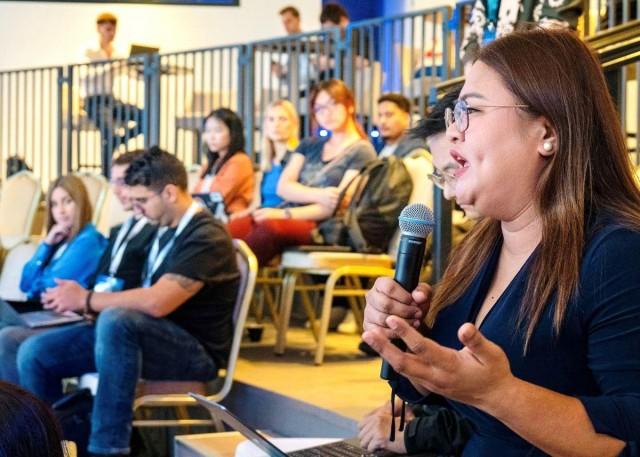Holding ground: Remodeling newsrooms in the age of AI

BUDAPEST, Hungary - As artificial intelligence (AI) reshapes industries around the world, journalists are left with a choice: either to keep up or risk falling behind. But how will it work for a profession that values a strict set of standards and principles such as credibility, reliability, and ethics?
The challenge right now is for journalists to keep up with technological advancements, while sticking to the same mission and purpose.
These are among my main takeaways in the recently-concluded 14th Asia-Europe Foundation Journalists Seminar (ASEFJS14) in Budapest, Hungary. ASEF chose 21 journalists from Asia and Europe to participate in discussions about the opportunities and challenges of the use of AI in journalism.

Among the topics discussed were: how AI can be used in journalism workflow and audience analytics, detecting misinformation and disinformation, and developing guidelines and best practices for AI use in journalism.

Need a wellness break? Sign up for The Boost!
Stay up-to-date with the latest health and wellness reads.
Please enter a valid email address
Your email is safe with us
AI has been the hottest buzzword of journalists across all platforms in all parts of the world.
But as AI specialists Pedro Henriquez and Jenny Romano said, AI is actually a boomer. It has been around for quite a while, like in the auto sum feature of Microsoft Excel, in the auto complete function in mobile phones and computers, and even in video games created since the 1950s.
What we have been dealing with recently has been generative AI, models that are trained to create new content based on patterns learned from existing data. ChatGPT is a popular example.
When it comes to generative AI, some journalists have led the way, tinkering with AI tools and incorporating them to the daily media workflow. Some have expressed hesitation, but are willing to learn. Others want absolutely nothing to do with it for fear of undermining the integrity of their work.
Most journalists I know, including myself, belong to the second group.

Sannuta Raghu, an AI expert and a journalist from the Indian media corporation scroll.in, concurs. She said journalists are skeptical, but are open to testing.
During her session, Raghu shared AI tools that can help journalists become more efficient and productive. After all, who does not want their jobs to be easier?
For example, probably the most mundane but an essential part of every journalist's daily to-do list is transcribing interviews. This becomes a nightmare for hours-long hearings or long press conferences. So it feels like a dream come true when the AI tool, GoodTape, among others, has significantly reduced time spent on transcriptions. In under five minutes, reporters can already get a full transcript of any interview, press conference, or hearing.
Here are Raghu's examples of AI tools that can help journalists in their daily tasks:
- Google Pinpoint and Humata: for extracting important parts of large documents or long texts
- Ellicit: for finding academic research that can be used to back stories
- Notebook LM: for quick summarization and note-taking
- Flourish: for creative data visualization or graphics
Many news organizations all over the world have also started incorporating AI in their workflow.
Singapore's Channel News Asia has been using AI to clip television segments for social media uploads. For time-pressed readers, CNA has also created summaries of their stories with the support of generative AI.
Malaysia's Star Media Group uses AI for translation and assisting graphic generation. They are also looking into automating some editorial processes like processing press releases.
The Times of India has tried using generative AI tools to create representative images for feature stories, in place of the usual available stock images. They also have also been using AI tools in their History section on social media to mark a significant day or event.
But lest we forget, AI must be used responsibly. This is why it is important to create guidelines and principles on the ethical use of AI in journalism.
As Hernandez and Romano said, editorial judgment is still of primary importance. AI should not lead decisions.
GMA Integrated News (GMAIN), for example, published in January the AI policies of the organization. Among the key guidelines are as follows:
- AI tools will be subjected to scrutiny before being implemented throughout the news production process.
- The AI tool must add value and improve workflow. It will be used as a tool to enhance our news gathering and content creation.
- AI will not replace manpower. It will not be used to sidestep critical thinking, encourage bias, lessen discourse, and proliferate mis/disinformation.
- Any published content produced by AI will be declared as such (“produced by AI” or “with the assistance of AI”) in the webpage, the image, the video still, or in other multimedia iterations. Parts produced by AI and the AI tools used will also be declared.
- Human judgment shall remain the final arbiter of all published content. Any AI-generated content shall be subjected to human oversight and editing from production to publication.
- We shall also be transparent when AI-produced content has had human editing. We shall make sure the AI-generated makes sense and aligns with our produced content.
Many news organizations around the world have also published their own set of guidelines regarding the use of AI.
After all, as much as AI is intelligent and helpful, it is far from perfect.
Raghu pointed out how AI tools have a tendency to operate based on stereotypes and lack of context. They also lack diversity and accuracy in languages.
Good old ethics and standards of journalism must still apply in every story.
Accuracy, Clarity, Fairness, and Balance are values that only humans can ascertain.
From the tambuli, to pen and paper, to the typewriter, then the microphone, radio, television, computer, and now, AI, journalism has truly evolved since the beginning of life on Earth.
But one thing is for certain: the need for reliable and truthful information will never become obsolete. Therefore, journalists will never become obsolete.
If there is one thing that the history of journalism has taught us, it is that no matter how much technology changes, journalists are bound to deliver the same mission: to speak the truth that will inform the decisions of people and will ultimately shape society.

Need a wellness break? Sign up for The Boost!
Stay up-to-date with the latest health and wellness reads.
Please enter a valid email address
Your email is safe with us





